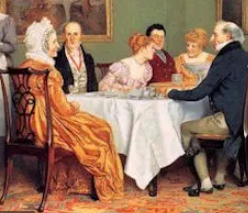By the end of the 18th century, travel by stage coach was becoming more common in England, especially for the middle and upper classes. Many outlying towns still had no coach services except for those that originated from London, but if one could reach a town or inn that lay along a stage-coach route (by carrier’s wagon, for example) then one could travel to London from any part of the country. People could also opt to travel by Kendal flying wagon, as illustrated below. Travel by stage-coach would have been similar to taking public transportation today, with inns and hostelries taking the place of hotels, motels, and restaurants. A changeover of a team of horses, or feeding them or watering them, would have been the equivalent of filling a tank with gas.

Kendal Flying Wagon, after Rowlandson
Dates and times of travel were clearly advertised, including the rates, which were 4 pence or 5 pence for a seat inside the coach, and 2 pence and 3 pence for sitting outside. These costs were prohibitive for the poor, who generally earned a shilling a week (12 pence). A seat outside the coach exposed a traveler to variable weather conditions and hazards, and it was not unusual for passengers to fall off a lurching coach or to be struck by a flying object.

Horses in snow, with passengers alighted to lighten the load
Long distance travel during this time was still a novelty, since the majority of the populace (around 90%) rarely traveled from their place of birth. Most English roads were in poor shape, rutted in good conditions and a muddy quagmire after heavy rains. In addition, people were accustomed to walking long distances, and it was not unusual for laborers to walk 6 miles to work.* The working class would not have chosen to pay for expensive transportation when two sturdy legs could carry them just as well. (Although I imagine a free ride on a friend’s wagon was always welcome.) As with public travel today, passengers could be seated alongside anybody – a considerate traveling companion, someone they instinctively disliked, or a person from a different class or station.
Macadamized roads were just beginning to be introduced during this period and their crushed stone surfaces allowed for greater speed and heavier loads to be carried. Travel time was reduced with these road improvements and with coach modifications, thus a good coach could go as fast as 6.4 miles per hour. This was at the expense of the horses, who lasted only an average of three years pulling heavy loads in all kinds of weather conditions and terrains. Royal Mail coaches went even faster than ordinary coaches, reaching speeds of up to 9 miles per hour, but these elite coaches represented only about 11% of the total coach mileage at its height. Below is a 1754 advertisement for the Edinburgh Stage Coach. Setting out on Tuesday in summer, the coach reached London in ten days. In winter, the journey would take 12 days. Ultimately, after road and coach improvements and before more efficient trains replaced coach travel as the preferred mode of transportation, the 400 mile trip between London and Edinburgh had been reduced to 40 hours, including all stops and relays (Harper Book of Facts).
Stage-coach and Mail in Days of Yore A Picturesque History of the Coaching Age … By Charles George Harper
- *Transport in Britain, 1750-2000, Phillip Bagwell and Peter Lyth, 2006, partial Google book








If I remember well the highest average speed around the 1810s was 12 miles per hour, including stops. Although such a pace was possible only on good roads, in a carriage with good springs system, and with a coat of arms.
Indeed, you are right, Sylwia. Royal mail coaches could go much faster than their lumbering stage coach counterparts, especially over well-paved macamadized roads, but a 12-mile-per-hour speed cost an enormous amount in resources, horses, and manpower, since the switch-over in teams had to be made at regular intervals. The speed with which one team of horses could be replaced by another can be likened to the incredible efficiency with which tires are replaced during pitstops at NASCAR races today. Swiftness was the key, but at a cost that was not available to the ordinary citizen.
Fascinating!!! Thank you so much for all the information :)
Does anyone know how many people could be seated in one coach, or did they all fit different amounts?
In charles Dickend novel “Pickwick Papers” he traveled by stagecoach from Tewkesbury stopping at Coventry, Dunchurch, Daventry and then Towcester.
Would this be the correct route as it seem not to be the direct route to Towcester from Tewkesbury
[…] 18th Century Road and Coach Improvements […]